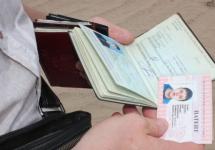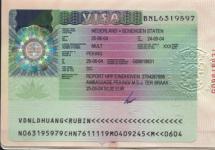A Schengen visa is an important permit that is placed by consular officers in the traveler's passport and gives the right to move freely between the countries participating in the Schengen agreement. An important feature of the Schengen area is the abolition of passport control at the borders between states. Today, there are 26 states that have signed the Schengen agreement. In order to visit any of them, possibly several in one trip, you must fill out an application for a Schengen visa, an important point in which will be the country of the first entry into the Schengen in the application.

After the route of travel around Europe is determined and the necessary documents are collected, you need to fill out for the issuance of Schengen. It is filled in electronically and in the language of the country where the visa is requested, or in English.
In total, there are 36 points in the questionnaire (the questionnaire of any state for obtaining a Schengen is identical), each of which must be filled out correctly and not to make mistakes.
In addition to personal and basic information (surname and name, citizenship, place of residence, marital status, etc.), you need to enter passport data and information about the employer in the questionnaire. Further, starting from point 21, it is necessary to indicate:
- Purpose of the trip.
- The purpose of the requested visa.
- Information about past Schengen.
- Expenses during the stay on the trip and the place of stay.
Items 22 and 23 are information about the host country. 22 point is the destination, i.e. the name of the country for which the visa is being requested. The next item is the name of the country of first entry, i.e. country, the border of which, in a trip through the Schengen zone, the traveler crosses first.

The questionnaire ends with four signatures. In paragraph 37, the signature confirms the authenticity of all the completed information above. The second signature confirms that the requested person is aware of the non-refund of consular and service fees in the event that a visa is denied.
The third signature is that for the first entry into the Schengen area, health insurance has been provided. The last signature is placed after a small text stating that the visa applicant agrees to the processing of personal information.
When filling out the questionnaire, you should pay attention to the following points, in which mistakes are often made:
- The first 3 items - last name and first name, are filled in exactly by letter, as indicated in the passport.
- 7 point - citizenship is indicated as Russian Federation, but not Russia.
- 9 point - marital status, where the status is married / married - with an official marriage.
- 10 point - for a minor applicant for Schengen, in an empty cell, the data of the legal representative of the child are entered.
- 16 point - the state that issued the passport, without indicating the data of the passport department.
- 17 point - the home address of residence, even if the address is different at the registration.
- 21 points - the common purpose of the trip is tourism;
- The next 2 points should not be confused with each other. 22 is the country of destination, the place where the visa is requested and where the main time of stay is planned, point 23 is the country of the first entry, the first crossing of the Schengen zone border, even if it is a transit trip;
- 25 point - the total number of nights (namely nights) in all Schengen states;
- 31 points - the place of stay. The contacts of the inviting person are indicated if the trip is by invitation; if the stay will be in hotels of several states, then the contacts of the hotel where the first stop is planned are entered.
When planning a trip to several Schengen countries
Obtaining a Schengen implies the intention to visit several countries within the Schengen area in one trip - this is logical. And if the traveler wants to see the whole of Europe, he must decide which country he will give preference to on the trip. The advantage can be measured in the maximum number of days spent in the territory of a state. This will be the country of destination. You will need to apply for a visa at her Consulate.
All other countries on the route will be visa-free. If you plan to visit several of them, with the same number of days in the territory, then the country of destination is defined as the one whose border will be crossed first. The number of states visited is limited only by the availability of financial resources.
If the Consulate of the country provides an annual multiple visa, this means that you can enter it several times during the year, but you can stay no more than 90 days in one trip. This interval should include the total number of days of travel throughout the Schengen area.

Choosing a country for applying to the Consulate for a visa
Immediately after the decision is made to process the Schengen, the traveler may have doubts about whether he will be issued a visa in the end or not. The choice of the country for applying to the Consulate, in this case, can play a significant role. After all, the best solution will be the state with the lowest percentage of refusal to issue a document.
The states of the Schengen agreement differ from each other in matters of issuing / not issuing a visa, a different package of documents and requirements for each applicant for a visa. For any country, the official employment of the applicant and his income are especially important. What consular employees pay special attention to and what conditions are priority for them determine the difficulty in obtaining a Schengen.

According to statistics, in 2019, the following states distinguished themselves with the most loyal attitude towards foreign tourists:
- Finland. The easiest country to get Schengen. When you first contact the Consulate, a Schengen visa is issued for 30 days. With a second appeal, it is possible to get a multivisa.
- France. Traveling citizens are provided with a multivisa for 5 years, and those who have not been to France - immediately for a year. The advantage is that you only need to collect documents once before the first trip. The minimum requirement for obtaining a multivisa is the presence of any Schengen in the passport.
- Spain. Her Consulate quite easily issues a multivisa for a period of six months even to those travelers who do not have a Schengen stamp. When processing a document, visa workers pay special attention to the terms of stay and a well-filled application form.
- Italy. It will be easy to enter here if you have Schengen Italian visas, and if at least 2 Schengen visas are received in 2.5 years, then the applicant will be able to obtain a multi-visa for more than a year.
- Greece. Subject to the presence of any Schengen in the passport, the Greek multivisa is issued for a period of six months. When applying again, the applicant can expect to receive an annual multiple visa, and then for a longer period up to 5 years.
- Slovakia. A visa is issued mainly for a year, but there are cases of issuance for both 2 years and 5 years. All information must be obtained at the visa centers of the state, and attention is paid to the number of days spent on the territory of Slovakia. It is worth noting that the visa begins to be valid from the moment of the first day of entry into the country.
Also, it is quite easy to get a Schengen to Poland, as there is a policy of attracting tourists, but the Consulate pays special attention to the finances of the tourist, the availability of movable and immovable property, so that he can ensure his stay in Poland.
Country of first entry rule
If there is a clear plan for which countries in Europe the tourist is going to go to, surely he A singles out one of them, where he wants to stay longer than the others. In this case, he must know that the state he has chosen will be the main country of residence of his trip, and he must request a Schengen from the Consulate of this particular country. According to it, he will be able to move freely through the territory of all 26 states participating in the Schengen agreement during the period for which the Schengen is issued. But he is obliged to spend the greatest number of days in the territory chosen by him, the main state.

As for the rule of the country of first entry, this is only a formality. There is no such rule. There is some provision in the Schengen Convention, which states that if a tourist has not decided on the place of main stay on his trip and spends approximately the same number of days in different Schengen countries, then a visa must be issued at the Consulate of the state whose border he crosses first . Violation of this Schengen visa rule may lead to problems with the issuance of a Schengen visa in the future, up to a ban for several years.
If a tourist travels in transit to the country to which he has issued a visa, across the border of another state, he will have to explain how much he needs this transit. If necessary, submit documents confirming this fact (hotel reservation, air ticket to the final destination, invitation).



